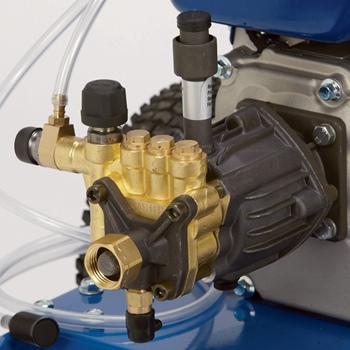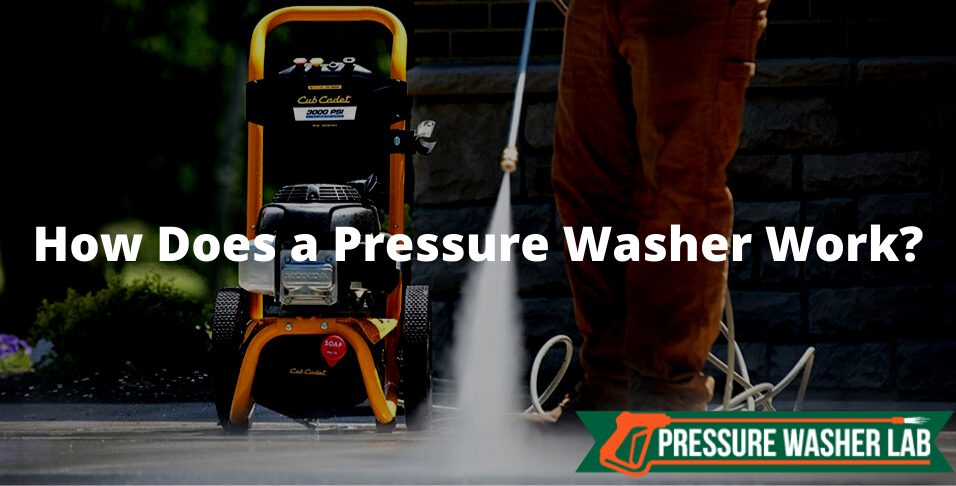A pressure washer works as follows:
- The operator turns on the water source.
- The pressure washer engine/motor is turned on and provides power to the pump.
- The pressure washer pump sucks in water and detergent, mixing them.
- The pump creates pressure and propels the cleaning solution through a high-pressure hose.
- The high-pressured jet moves on to the trigger gun and comes out of the pressure washer through a nozzle tip that enhances its pressure levels.
The pressure washer terminology needed to understand how a unit works, what the essential parts of a pressure washer are, the features involved, and the actual working mechanism of a power washer are explained in detail below.
The Working Mechanism of a Pressure Washer
 The operator needs to turn on a water source before the pressure washer starts and to connect a detergent bottle if the pressure washer is not equipped with an onboard detergent tank. The former step is optional.
The operator needs to turn on a water source before the pressure washer starts and to connect a detergent bottle if the pressure washer is not equipped with an onboard detergent tank. The former step is optional.- Water comes into the pressure washer through the water inlet of the unit from a faucet or a water tank, through a garden hose. Portable pressure washers that are powered by batteries are equipped with a water tank.
- For cleaning tasks that require the use of pressure washer detergents, these chemicals are added through a detergent hose.
- The engine or the motor of the power washer is turned on when the operator pulls the handle of a gas pressure washer or moves the power switch to ‘On’ if using an electric unit.
- The engine/motor turns on the pressure washer pump that sucks in the water and the chemicals and mixes them together. This happens only when the operator presses the trigger of the gun.
- Hot water pressure washers heat the water before it is propelled out of the unit using a burner assembly.
- The water cleaning solution is propelled out of the water outlet of the pressure washer through a high-pressure hose.
- The nozzle selected by the operator increases the pressure of the water spay according to its capacities.
PSI, GPM, CP, and CU
Pressure washers are different from one another in terms of pressure, water flow, and total power. These ratings are indicators of a pressure washer’s performance and give information about how powerful it is and what it is suited for.
PSI
The PSI of a pressure washer is an indicator of how much pressure the unit produces. PSI comes from Pounds per Square Inch, which means that it describes how much pressure, in pounds, the water stream applies to a surface of one square inch. Pressure washers have minimum and maximum pressure rates and can deliver different PSI levels within this range, according to the operator’s needs.
PSI ratings are often come across when talking about pressure washer attachments. In this case, the PSI is an indicator of these parts’ compatibility with different units. For example, a pressure washer hose can be described as a 3700 PSI hose, which means that this model can withstand pressure levels below or equal to 3700 PSI and not that it produces pressure.
The PSI of a power washer is relevant when deciding what pressure washer to use for different cleaning tasks in order not to damage the surface that needs to be pressure washed. For example, pressure washing a car requires a maximum of 1900 PSI, but when it comes to rougher surfaces, such as concrete, the PSI needed is higher if deep cleaning is the target.
Are PSI and Bar the Same?
PSI is different from Bar even though they both measure pressure. Bar measures the force applied perpendicularly to a surface’s unit and is equal to 14.5 PSI. Following this knowledge, if the pressure of a power washer is expressed as 204 Bars, the pressure measured in PSI is equal to approximately 2958 PSI.
GPM
The GPM rating of a pressure washer indicates how much water the unit can deliver in one minute, measured in gallons. GPM is the abbreviation of ‘Gallons Per Minute’.
The GPM of a unit is relevant because a pressure washer can be more or less powerful according to this indicator, even if it delivers high PSI levels. If a power washer delivers high-pressure levels at low water flow, the total power of the unit is lower. The reason why this happens is explained in the next section.
CP
The CP represents the total power of a pressure washer and is an abbreviation of ‘Cleaning Power’. The total cleaning power is calculated by using the following formula: CP = PSI * GPM. The pressure rate is multiplied by the quantity of water that the power washer can deliver.
The CP of a pressure washer indicates the weight that is being applied to 1 square inch in 1 second. This weight is composed of the water weight and the pressure that is applied to it. The higher the water flow rate or the pressure rate is, the higher the CP.
If a pressure washer has a maximum pressure rate of 3000 PSI and 3.0 GPM, it will be more powerful than a unit that generates 4000 PSI at 2 GPM because the CP of the second unit is lower. This CP is 8000, while the CP of the first pressure washer is 9000.
CU
The CU of a pressure washer is the same as the CP and is an abbreviation of ‘Cleaning Units’. Whenever CU is used to describe a power washer, it is used to describe the same thing, how much pressure a cleaning unit can apply in 1 minute to an area of 1 square inch.
Pressure Washer Parts
Understanding how the components of a pressure washer work is essential to understanding what happens inside of a power washer. These components and their role are detailed below.
Pressure Washer Engine/Motor
The pressure washer gas engine or electric motor is one of the main components of a unit. Gas pressure washers, as well as gas engines, differ depending on the brand and on their constructions. These engines use fuel which they convert into power.
Electric motors can be brushless or brushed, which makes a difference in the performance and energy efficiency of an electric power washer. These motors use electricity from a static power source or are powered by batteries in order to make the pressure washer work.
Both types of engines have one role, that of giving power to the pressure washer pump. Regardless of how much power a pump can withstand, one main component that indicates how powerful a pressure washer is, is the engine or motor.
Pressure Washer Pump
 A pressure washer pump has the role of creating pressure that propels the water out of the power washer. There are 3 types of pumps used for pressure washers: wobble pumps, axial pumps, and triplex pumps. These pumps are either driven by pistons or by a crankshaft in order to generate pressure.
A pressure washer pump has the role of creating pressure that propels the water out of the power washer. There are 3 types of pumps used for pressure washers: wobble pumps, axial pumps, and triplex pumps. These pumps are either driven by pistons or by a crankshaft in order to generate pressure.
How high the water pressure is, is influenced by the power of the engine and by the pump type. Triplex pumps are the most powerful, and most heavy-duty power washers are equipped with this type of pump. More information on how power washer pumps work can be found in our pressure washer pump buying guide.
Pressure Washer Water Inlet and Outlet
A pressure washer water inlet is the place where the water comes into the unit through a garden hose. The water inlet allows the connection of a regular garden hose that is connected, on its other side, to a water source.
A pressure washer water outlet is the place where pressured water comes out of the unit through a high-pressure hose. The difference between the water inlet and the water outlet is the fact that the outlet is not equipped with a water filter. The role of the water filter is to filtrate the incoming water so that debris and other impurities will not damage the pressure washer.
High-Pressure Hose
Pressure washers require a special type of hose to be connected to the water outlet, as not all hoses resist high pressure. This is why all pressure washers require high-pressure hoses that are usually made of multiple plastic layers and use wire thread to prevent damage. The resistance of a hose to high pressure differs among models and not all are compatible with highly powerful pressure washers.
Pressure Washer Trigger Gun
The trigger gun of a pressure washer is an attachment that needs to be connected to the other side of the high-pressure hose. This attachment is essential because it is what allows the operator to control the water flow. By pressing the trigger, the operator signals the unit that they need pressured water to come out. By releasing the trigger, the pressure washer is commanded to interrupt the water flow. The role of trigger guns and their features are discussed in detail in our pressure washer guns buying guide.
Pressure Washer Nozzles
The pressure washer nozzles are accessories that are essential to influence the pressure that is applied to a surface. The role of a power washer tip is to restrict the water flow in such a manner that the water stream coming out of it is higher or lower, according to the operator’s needs.
Other Pressure Washer Features
Bypass Mode
The bypass mode of a pressure washer is a feature that allows the operator to release the trigger gun for a few minutes without turning off the unit. While the trigger is not engaged, the water is recirculated throughout the pump.
Pressure Relief Valve
The pressure relief valve of a power washer is a feature that protects the unit from damage. The role of this valve is to reduce the pressure when it gets too high. The settings of the pressure washer valve are set in the factory and changing them is not recommended.
Thermal Relief Valve
The thermal relief valve of a pressure washer is designed to detect the temperature levels inside the pump and, when they get too high, to open and release water in order to reduce temperature levels. Pressure washers that are equipped with this type of valve are more long-lasting and can be used for prolonged continuous periods.
Chemical Injection System
A pressure washer’s chemical injection system is a mechanism that mixes chemicals with water to ensure the perfect level of dilution for specific cleaning tasks. Not all power washers are equipped with such a system and, in this case, the operator needs to dilute detergents and soaps manually before using them inside the pressure washer.
The Construction of a Pressure Washer
Pressure washers are not the same in terms of design but there are similar factors that most of them have, as follows:
- The pressure washer engine/motor is encased in a protective foil that ensures that the component is not damaged by water.
- The engine of a pressure washer can be either vertically or horizontally shafted, which requires a pump that can be connected accordingly.
- The engine and the pump have a casing that is more or less solid, depending on the brand and the model.

